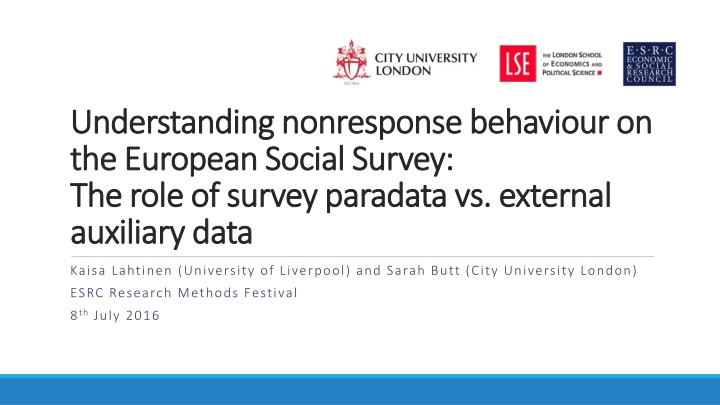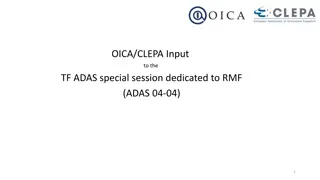
Understanding Nonresponse Behavior on the European Social Survey
Explore the role of survey paradata and external auxiliary data in understanding and predicting nonresponse behavior on the European Social Survey. Learn how multi-level multi-source auxiliary data can be utilized to enhance fieldwork efficiency and improve survey response rates. Discover the importance of different data sources such as paradata, small-area data, and commercial data in predicting survey nonresponse and where to invest resources effectively.
Download Presentation

Please find below an Image/Link to download the presentation.
The content on the website is provided AS IS for your information and personal use only. It may not be sold, licensed, or shared on other websites without obtaining consent from the author. If you encounter any issues during the download, it is possible that the publisher has removed the file from their server.
You are allowed to download the files provided on this website for personal or commercial use, subject to the condition that they are used lawfully. All files are the property of their respective owners.
The content on the website is provided AS IS for your information and personal use only. It may not be sold, licensed, or shared on other websites without obtaining consent from the author.
E N D
Presentation Transcript
Understanding nonresponse behaviour on Understanding nonresponse behaviour on the European Social Survey: the European Social Survey: The The role of survey role of survey paradata paradatavs. external auxiliary data auxiliary data vs. external Kaisa Lahtinen (University of Liverpool) and Sarah Butt (City University London) ESRC Research Methods Festival 8thJuly 2016
The problem o Declining survey response rates o Research into causes and correlates of nonresponse o Improve fieldwork efficiency (e.g. responsive design) o Post-hoc analysis and adjustments o Requires data that is o available for respondents and nonrespondents o predictive of response behaviour and substantive survey responses
The solution? Use multi-level multi-source auxiliary data (Smith and Kim, 2011) o Sample frame o Survey paradata oCall records o Interviewer characteristics oInterviewer observations o External data sources oSmall area admin data e.g. census oCommercial data bases
The solution? Multi-level multi-source auxiliary data (Smith and Kim, 2011) o Sample frame o Survey paradata oCall records o Interviewer characteristics oInterviewer observations Which is most useful for predicting survey nonresponse? Where should surveys invest resources? o External data sources oSmall area admin data e.g. census oCommercial data bases
Comparing data sources Paradata Small-area data Commercial data Timeliness Completeness Unit of analysis Accuracy ? Cross-national comparability Cost ~
Comparing data sources Paradata Small-area data Commercial data Timeliness ~ Completeness x Unit of analysis x Accuracy ? ? Cross-national comparability x x Cost ~ x
ADDResponse o Auxiliary Data Driven nonResponse bias analysis (ADDResponse) o European Social Survey Round 6 (2012/13) o 54% response rate (34% refusal, 7% non contact) o Clustered PAF sample of 4,520 addresses in 220 PSUs o Append geocoded auxiliary data o Small area data (census, DCLG, HO, DfE, DWP etc.) o Commercial data o OS Points of Interest data o Interviewer observations
ADDResponse: Interviewer observations o Five interviewer observations collected for all sampled addresses oType of dwelling unit (1= multi-person occupancy 0=single occupancy) oBarriers to entry present (1= yes 0= no) oPhysical condition of property ( 1 = very good 5 = very bad) oLitter (1=present 0 = not present) oGraffiti (1=present 0 = not present) o Observations complete for 97 % addresses oInterviewer observations correlate with census data - > none recorded in OAs where there are no flats
ADDResponse: Commercial data oData purchased from two value added resellers o Consumer segmentation variables: ACORN, MOSAIC etc. o Specific variables e.g. length of residency, tenure, house price, age, employment status, children present, marital status o Consumer preferences data (very patchy) o Data from 2015 but ESS fieldwork completed 2013 o Missing data o Company 1: 10% Company 2: 20 -50% o Differences between two commercial databases oN of adults = 54% match Tenure =75% o Discrepancies compared with ESS data o N of adults = 71% match Married = 77% match Retired = 87% match
Modelling and methods o Logistic regression: response vs. not o Controlling for clustering at PSU level o Nested models oCoefficients o Model fit
Modelling and methods o Logistic regression: response vs. not o Controlling for clustering at PSU level o Nested models oCoefficients o Model fit o Models o Model 1: interviewer observations o Model 2: Model 1 + small area data o Model 3: Model 2 + commercial data (MOSAIC) o Model 3 a : Model 2 + commercial data (separate variables)
Results: Interviewer observations Response vs. not Log odd 0.608*** (0.024) -0.133*** (0.03) -0.032 (0.029) 0.052 (0.04) -0.007 (0.025) -0.029* (0.011) 0.034 1025.34 Variable (Intercept) Access Living in a flat Vandalism Litter Physical condition R2 AIC
Results: Interviewer observations Response vs. not Log odd 0.608*** (0.024) -0.133*** (0.03) -0.032 (0.029) 0.052 (0.04) -0.007 (0.025) -0.029* (0.011) 0.034 1025.34 Contact vs. not Log odd 0.976*** (0.011) -0.086*** (0.026) -0.080*** (0.022) -0.008 (0.024) -0.019 (0.0151) -0.008 (0.006) 0.086 290.91 Variable (Intercept) Access Living in a flat Vandalism Litter Physical condition R2 AIC
Results: Interviewer observations Response vs. not Log odd 0.608*** (0.024) -0.133*** (0.03) -0.032 (0.029) 0.052 (0.04) -0.007 (0.025) -0.029* (0.011) 0.034 1025.34 Contact vs. not Log odd 0.976*** (0.011) -0.086*** (0.026) -0.080*** (0.022) -0.008 (0.024) -0.019 (0.0151) -0.008 (0.006) 0.086 290.91 Refusal vs. not Log odd 0.341*** (0.023) 0.104** (0.034) -0.037 (0.032) -0.044 (0.042) -0.012 (0.024) 0.026* (0.011) 0.019 866.88 Variable (Intercept) Access Living in a flat Vandalism Litter Physical condition R2 AIC
Results: Including auxiliary data Deviance (Model 1 vs Model 2) Deviance (Model 2 vs Model 3) Deviance (Model 2 vs Model 3 a) P - value Model 2 6.438 0.3701 Model 3 48.401 0.0000 Model 3 a 29.505 0.0002
Results: Including auxiliary data o Interviewer observations remain significant o Other significant auxiliary variables oModel 2 o None oModel 3 o MOSAIC oModel 3a o Children present o Full-time employment o Missingness from commercial data o (single and recent movers, but only at 10% level)
Conclusions o ESS interviewer observations helpful in predicting nonresponse o Quality issues with commercial variables and minimal improvement in model fit oNo silver bullet for modelling survey nonresponse o Further research needed into o Validating interviewer observations o Conditions under which observations are more/less accurate
Find out more www.addresponse.org sarah.butt.1@city.ac.uk Kaisa.lahtinen@liverpool.ac.uk
References Sinibaldi, J., Durrant, G.B. and Kreuter, F., 2013. Evaluating the measurement error of interviewer observed paradata. Public Opinion Quarterly, 77(S1), pp.173-193. Sinibaldi, J., Trappmann, M. and Kreuter, F., 2014. Which is the better investment for nonresponse adjustment: purchasing commercial auxiliary data or collecting interviewer observations?. Public Opinion Quarterly Sturgis, P. and Brunton-Smith, I., 2012. An assessment of the potential utility of interviewer observation variables for reducing non-response error in the National Survey for Wales. Vercruyssen, A., Wuyts, C. and Loosveldt, G., 2016. Auxiliary data for the European Social Survey Belgium. A search for easily available and straightforwardly useable external data. West, B.T. and Kreuter, F., 2013. Factors affecting the accuracy of interviewer observations evidence from the National Survey of Family Growth. Public opinion quarterly, p.nft016. West, B.T., Wagner, J., Hubbard, F. and Gu, H., 2015. The Utility of Alternative Commercial Data Sources for Survey Operations and Estimation: Evidence from the National Survey of Family Growth. Journal of Survey Statistics and Methodology, p.smv004.





